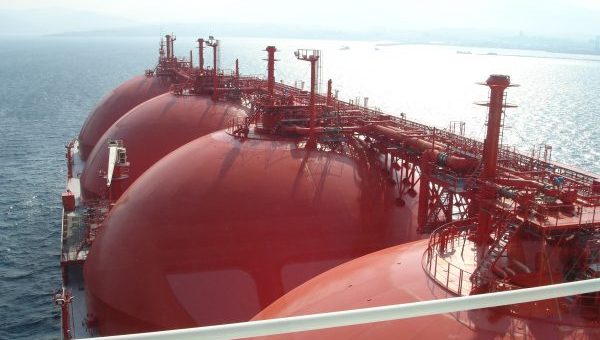LNG prices edge higher as returning production weighs

Production problems and increased demand in Turkey and France helped LNG prices stay steady despite a drop in demand from China and Japan. Maritime Connecter photo by Eric Superina.
LNG prices buoyed by fresh buying, tenders
MILAN, Jan 6 (Reuters) – Asian spot LNG prices were buoyed by new purchases and tenders but stayed below recent two-year highs this week as two outage-hit plants resumed output.
The price of LNG for February delivery rose to $9.75 per million British thermal units (mmBtu), 25 cents above last week’s levels, traders said.
Though Japanese and Chinese demand cooled, trade sources said Korea Gas Corp was open to possible purchases despite having secured a recent shipment from Angola and contracted for winter cargoes in December via a tender.
Gail India, which launched a tender to buy three cargoes between January-March, in the end decided to just award the February shipment at an estimated price in the mid to high $9 per mmBtu range, trade sources said.
Traders took this as a sign of slack demand in a market that has so far proven surprisingly resilient to rising Asian prices, up 137 per cent since mid-April.
BHP Billiton sold a cargo from Australia’s North West Shelf export facility to an unidentified buyer which some said was Chevron Corp for a price in the high $9 per mmBtu range.
“The market is looking at this deal closely as it can set the tone for 2017 prices,” a Singapore-based trader said.
Trade sources pointed to Chevron’s urgent need to replace lost output from its two disabled export facilities as one possible driver for paying BHP Billiton a relatively high price.
However, Chevron’s LNG production outlook brightened significantly as 2017 got underway with both its Angola LNG facility, and the giant Gorgon project in Australia, restarting production this week following a month-long outage.
The impact on prices was expected to be gradual as traders waited to see whether production could be sustained given both plants’ uneven performance through 2016.
Thailand’s state-run PTT was said to have launched a tender seeking cargoes for delivery in February and March, according to one trader, although exact details could not be confirmed.
Traders were also watching for a potential production stoppage at Sonatrach’s Arzew LNG plant in Algeria.
Six LNG tankers were anchored outside Arzew port and there was little discernible activity, according to Thomson Reuters shipping data.
Turkey and France accounted for the biggest share of Atlantic LNG demand.
Since embarking on a LNG buying spree in December to meet higher gas consumption due to cold weather, Turkey continues to be an attractive market for Atlantic producers, traders said.
Demand for gas to generate electricity is so high that it has pushed power prices to record highs, forcing Turkey’s energy watchdog to impose price caps on prices.
LNG shortages in southern France have stoked wholesale natural gas hub prices to well above levels in neighbouring markets, and which has prompted calls from GRTgaz, the system operator, for shippers to bring in extra supplies.
(Reporting by Oleg Vukmanovic in Milan and Mark Tay in Singapore; Editing by David Evans)

Ph: 432-978-5096 Website: www.mapleleafmarketinginc.com







